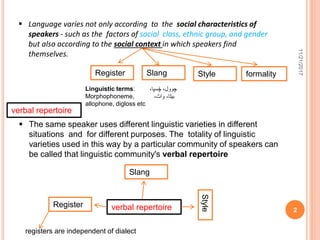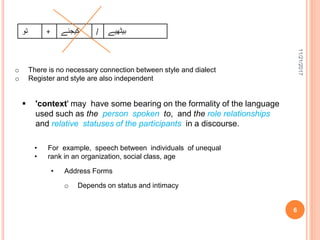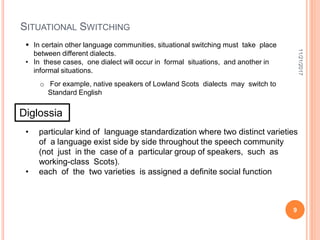Language and context
- 1. Language and Context 1 SOCIOLINGUISTICS: AN INTRODUCTION TO LANGUAGE AND LINGUISTICS ZUBAIR A. BAJWA 11/21/2017 Department of English, University of Gujrat, Gujrat, Pakistan BY M. Phil English Linguistics CHAPTER: 5 IN PETER TRUDGIL zbr141@gmail.com
- 2. 11/21/2017 2  Language varies not only according to the social characteristics of speakers - such as the factors of social class, ethnic group, and gender but also according to the social context in which speakers find themselves.  The same speaker uses different linguistic varieties in different situations and for different purposes. The totality of linguistic varieties used in this way by a particular community of speakers can be called that linguistic community's verbal repertoire verbal repertoire Register Slang Style Register Slang Style verbal repertoire registers are independent of dialect formality Linguistic terms: Morphophoneme, allophone, digloss etc ،‫سپا‬ُ‫چ‬ ،‫چوول‬ ،‫واٹ‬ ،‫بیٹا‬
- 3. 11/21/2017 3  These social factors control which variety from this verbal repertoire is actually to be used on a particular occasion. Style formal informal • situation, • social familiarity, • kinship-relationship, • politeness, • seriousness subsumes very many factors including situation, social familiarity, kinship-relationship, politeness, seriousness formality in office Talking to strangers Talking to family members Acknowledging other’s face
- 4. 11/21/2017 4 Example • Style can be ranged on a continuum a series of similar items in which each is almost the same as the ones next to it but the last is very different from the first • In English style is characterized by vocabulary and sentence structure; it can also be pronunciation. o Slang is an example of vocabulary o Passive voice and active voice is an example of sentence structure • In other languages, style can be more inflexible o You may have to choose from pronouns and suffixes. For example, Urdu. o Pronouns: o ،‫آپ‬ ،‫تم‬ ،‫تو‬ o ‫ان‬ ،‫اس‬
- 5. 11/21/2017 5 o Verbal suffixes o ،‫آپ‬ ،‫تم‬ ،‫تو‬ o ‫ان‬ ،‫اس‬ ‫کر‬ ‫بیٹھ‬ ‫کرو‬ ‫بیٹھو‬ ‫کریں‬ ‫بیٹھیں‬ ‫کرئیے‬ ‫بیٹھیے‬ ‫کیجیے‬ Formal informal ‫بیٹھ‬ ‫رکھیں‬ ‫تشریف‬ o Co-occurrence restrictions also occur at each level ‫تو‬ + ‫کر‬ / ‫بیٹھ‬ ‫تم‬ ‫کرو‬ / ‫بیٹھو‬ ‫آپ‬ + ،‫کرو‬،‫کریں‬ ‫کیجئے‬ / ‫تشریف‬‫رکھیں‬
- 6. 11/21/2017 6 ‫تو‬ + ‫کیجئے‬ / ‫بیٹھیے‬ o There is no necessary connection between style and dialect o Register and style are also independent  'context' may have some bearing on the formality of the language used such as the person spoken to, and the role relationships and relative statuses of the participants in a discourse. • For example, speech between individuals of unequal • rank in an organization, social class, age • Address Forms o Depends on status and intimacy
- 7. FOR EXAMPLE 11/21/2017 7 English Urdu First name Last name Family name John Diggle First name Last name Family name Riaz Ahmad Mangrio • Formal addressing • informal addressing • Close friends addressing o Mr Diggle o John o Dig. • Formal addressing • informal addressing • Close friends addressing o Riaz Sahab o Mangrio sahab o Mangrio o Riaz
- 8. 11/21/2017 8 • “Sir” o In Pakistan, it is commonly used as a form of address in formal contexts o In the USA, it a common form of address used to address unfamiliar persons. • ‫جی‬ ‫استاد‬ o Uneducated social class generally used this phrase to address persons high in status and unfamiliar ones.
- 9. SITUATIONAL SWITCHING 11/21/2017 9  In certain other language communities, situational switching must take place between different dialects. • In these cases, one dialect will occur in formal situations, and another in informal situations. o For example, native speakers of Lowland Scots dialects may switch to Standard English • particular kind of language standardization where two distinct varieties of a language exist side by side throughout the speech community (not just in the case of a particular group of speakers, such as working-class Scots). • each of the two varieties is assigned a definite social function Diglossia
- 10. 11/21/2017 10 Diglossia Low Variety High Variety Arabic: colloquial Classic Urdu: colloquial Classic ÔÇß High Variety: used in sermons, formal letters, political speeches, university lectures, news broadcasts, newspaper editorials, and 'high' poetry ÔÇß Low variety: conversation with family and friends, radio serials, political and academic discussions, political cartoons, and 'folk' literature The most important feature the specialization of function of the two varieties
- 11. 11/21/2017 11 • low diglossic variety is standardized • the two varieties have names and are felt to be distinct the situations where each is to be used are socially fairly well defined and - and this is of great importance - no section of the community regularly uses the high variety as the normal medium of everyday conversation.  Main differences between diglossic and other situations • The high variety has no native speakers and in all cases has to be learnt as a school language. • This is why the situations where the high variety is used involve either written language or, if spoken language is involved, tend to be situations where preparation is possible. Where, in isolated cases, individuals do attempt to use the high variety in everyday speech this is generally felt to be artificial, pedantic, snobbish
- 12. 11/21/2017 12 • Linguistically speaking, the differences between the two varieties may be considerable. o Many of the differences are vocabulary differences. o Many pairs of words may occur, referring to common objects or concepts, where the meaning is roughly the same, but where the usage of one item rather than another immediately indicates high or low variety.












